Publication
Article
Cardiology Review® Online
Early statin treatment after acute myocardial infarction
Author(s):
To evaluate whether the early use of statins would reduce cardiovascular events, we conducted a prospective, randomized trial that included 486 patients with acute myocardial infarction and normal total cholesterol levels, of whom 241 patients received statin therapy. The statin group had a lower risk of congestive heart failure and symptomatic myocardial ischemia, which indicates that early treatment with statins reduces recurrent cardiovascular events.
Milestone large, randomized, controlled trials, such as the Scandinavian Simvastatin Survival Study (4S),1 the Cholesterol and Recurrent Events (CARE) trial,2 and the Long-Term Intervention with Pravastatin in Ischaemic Disease (LIPID),3 have shown that HMG-CoA reductase inhibitor (statin) therapy initiated 3 to 6 months after the onset of acute myocardial infarction (MI) reduces mortality in patients with elevated cholesterol levels. In addition, early statin treatment initiated during hospitalization for acute coronary syndrome (ACS) is also beneficial, as shown by the Myocardial Ischemia Reduction with Aggressive Cholesterol Lowering (MIR ACL) study.4 In that study, patients with ST-segment elevation or those who had undergone percutaneous coronary intervention (PCI) procedures were excluded from enrollment; therefore, the effects of statin treatment in those patients are not known.
It has also been reported that in patients with established coronary artery disease other than ACS,5,6 and in those with dilated cardiomyopathy,7 some statins are effective in preventing heart failure events. We conducted a prospective, randomized, open-label trial to determine whether early statin treatment would have an effect on heart failure and ischemic events in patients with acute MI and ST-segment elevation following PCI.
Patients and methods
The current study was conducted in 54 hospitals in 28 prefectures in Japan and included 486 consecutive patients with acute MI. When necessary, acute-phase reperfusion therapy, including thrombolysis or PCI, or both, was performed following hospital admission. Within 96 hours after symptoms began, patients were assigned to receive conventional therapy without statins or conventional therapy plus open-label statin treatment with 1 of the following statins available in Japan at that time: pitavastatin (Livalo), simvastatin (Zocor), fluvastatin (Lescol), atorvastatin (Lipitor), or pravastatin (Pravachol). No other lipid-lowering drugs were permitted during the trial; however, physicians were allowed to alter the dosage of the drug or to change patients to another statin drug, if needed.
The composite of cardiovascular death, nonfatal acute MI, recurrent symptomatic myocardial ischemia with objective evidence and requiring emergency rehospitalization, congestive heart failure requiring emergent rehospitalization, and nonfatal stroke was the primary end point. Clinical events were determined by 6 independent cardiologists blinded to drug allocation, who also monitored the data and safety. The follow-up period was 24 months from drug initiation.
Results
A total of 486 patients were enrolled during the study period, of whom 245 received conventional treatment without statins and 241 received conventional treatment plus statins. We excluded patients with fatal complications that occurred within a week following the onset of symptoms, such as left ventricular free wall rupture. There were no significant differences in baseline characteristics of patients who survived acute-phase complications (244 patients in the nonstatin group and 237 patients in the statin group). The mean follow-up period was 416 ± 11 days. The number of smokers in both groups was high, and approximately 90% of patients had ST-segment elevation MI. More than 90% of these patients had coronary angioplasty. Because drug-eluting stents were not available in Japan at the time of the study, only bare metal stents were used (
).
P
Both groups had similar serum lipid levels at the start of the study. The mean total cholesterol level was 207 mg/dL. The mean high-density lipoprotein (HDL) cholesterol level was 46 mg/dL, the mean low-density lipoprotein (LDL) cholesterol level was 133 mg/dL, and the mean triglyceride level was 134 mg/dL. In the nonstatin group, the total and LDL cholesterol levels were reduced by 1% and 4%, respectively, at 6 months; by 1% and 6%, respectively, at 1 year; and by 3% and 8%, respectively, at 2 years. In the statin group, however, total and LDL cholesterol levels were reduced by 13% and 24%, respectively, at 6 months; by 14% and 27%, respectively, at 1 year; and by 17% and 25%, respectively, at 2 years. Compared with patients taking conventional statins, who had a reduction of 21% in LDL cholesterol level at 2 years, patients taking newer statins, such as pitavastatin or atorvastatin, had a reduction of 35% ( < .05).
During the follow-up period, 11.4% of patients in the nonstatin group experienced the primary end point, compared with 5.9% in the statin-treated group, which is an absolute difference of 5.2%. As shown in
, the risk of the primary combined end points was markedly decreased in the statin group during the follow-up period. Both groups had similar rates of stroke, acute MI, and mortality. There was a lower risk of congestive heart failure requiring emergent rehospitalization in the group taking statins, however (
). After 6 months of treatment, the prevention of heart failure among patients in the statin group became obvious. Compared with patients in the nonstatin group, patients in the statin group experienced symptomatic myocardial ischemia requiring emergent rehospitalization more often.
Discussion
Among Japanese patients with acute MI who received statin therapy, cardiovascular events, including unstable angina and congestive heart failure, were reduced compared with patients who did not receive statin therapy. The relative reduction of the primary end point was 42%, and the absolute reduction was 4.3%. In another study, Japanese patients with ACS who were treated with atorvastatin for 6 months had a marked decrease in plaque volume of the coronary arteries, as shown by serial intravascular ultrasound.8 The positive effects of statins shown in our study, especially the prevention of unstable angina, may have been the result of a reduction in plaque volume. Because the number of hard end point events was small in our study and because it was an open-label trial, study results may have been tempered.
Additional data regarding the favorable benefits of early statin treatment in acute MI patients with normal total cholesterol levels were provided by the results of our study. Most of our patients had ST-segment elevation MI, had undergone PCI procedures, and had received statins soon after symptoms began, in contrast to earlier studies. ACS patients with ST-segment elevation and patients who had undergone coronary artery bypass graft surgery or PCI were excluded from the MIRACL study, even though statin treatment was started within 24 to 96 hours after acute MI.4 Patients with new pathological Q waves were included in the Fluvastatin on Risk Diminishment After Acute Myocardial Infarction (FLORIDA) study because it was assumed that most of them had ST-segment elevation in the acute phase of the MI.9 But only 3% of those patients underwent PCI, only 50% received fibrinolysis, and fluvastatin was started up to 8 days after symptom onset. The patients in our study may have reflected typical patients seen in clinical practice in that they had normal total cholesterol levels, had ST-segment elevation MI, and underwent PCI. In addition, we permitted the use of any statin available in Japan at that time.
The results of our study showed that the incidence of symptomatic heart failure was markedly reduced in patients taking statins after acute MI compared with those who did not take statins. This indicates that left ventricular function may be preserved with statins. A previous study showed that among patients with dilated cardiomyopathy, 10 mg of simvastatin improved cardiac symptoms and function, which may have occurred as a result of reduction in systemic inflammation.6 This same mechanism may have been responsible for the lower risk of heart failure seen in our study, even though our patients had different baseline characteristics.
Conclusion
Among 486 patients with acute MI and normal cholesterol levels, we showed that administration of statins within 96 hours of symptom onset resulted in a lower risk of congestive heart failure and symptomatic myocardial ischemia. This indicates that early treatment with statins reduces recurrent cardiovascular events, especially congestive heart failure.






